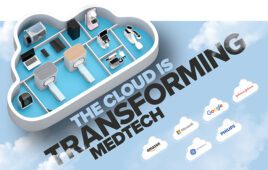Ever hear of edge computing? If you’re in healthcare, you will soon if you haven’t already, according to experts.
The reason is IoT.

BioLert records seizure-like events and tracks the patient. Caregivers are notified in real-time if a seizure occurs.
IoT devices such as fitness wearables, glucose monitors, telehealth tools and other sensors are poised to revolutionize health. But there are some barriers that are keeping IoT from realizing its full potential in the healthcare space.
The trouble with these products is the data are messy. Information is unstandardized and poorly-defined. When clinicians are confronted with such data, they become overwhelmed and are unlikely to use the products.
Even more troubling, Health IT managers, data integrity experts and EHR designers have long predicted that the volume of data contained in these devices could easily overtax existing systems.
To be clear, we are no longer talking about terabytes. “The ‘Internet of Everything’ — all of the people and things connected to the internet — will generate 507.5 zettabytes (1 zettabyte = 1 trillion gigabytes) of data by 2019,” according to a report from Cisco.
In healthcare, even a small portion of such volumes could spell disaster.
Finally, right now, big data can take days, weeks or even months to make the journey from its source to its end-user. If data cannot be analyzed quickly enough, the value, particularly in healthcare, is reduced.
Even for real-time analytics, healthcare currently uses cloud solutions to store data once it is collected from the device. Cloud middleware takes the data and pulls relevant material into an analytics system. That message is then delivered to the user interface. The process can take a few seconds, or several minutes, belying the “real-time” promise.
Getting from data to insight – faster
Edge or fog computing shortens the time between data capture and insight. It upends the system somewhat by enabling devices to conduct critical analysis on their own. Edge computing adds a layer of computing power between the device and the cloud storage process so that inpatient care, patient engagement, population health management, and remote monitoring get a boost of speed.
Critical analytics are closer to the device. In fact, each device becomes a processing node that can handle small, time-sensitive tasks without the need to send all data to the cloud. These narrowly defined tasks are processed in milliseconds. The system also frees up larger-scale cloud analytics.
Check out our latest coverage on cloud technology:
5 mistakes found in cloud-connected medical devices
The Cisco report noted that healthcare will be among the first 5 industries to adopt edge (or fog) computing. Healthcare is already seeing some adopters.
Real world, real time
Heather Ailara, marketing director for BioLert said that engineers at her company have been talking about using edge computing for a while now. “It is the next big thing in computing.”
For BioLert, edge computing represents a way for their system’s processing to be done quickly on the end device without stressing battery power or requiring the cloud.
BioLert is a software as a service (Saas) product that monitors epileptic patients, detects epilepsy episodes, and notifies caregivers or family members when an event occurs. The product also records all tracked data (including video and audio, if available) and stores it in the cloud.
Ailara said the notification feature is a primary benefit, along with the cloud data. BioLert essentially creates an accurate diary of patients’ vitals and events. That diary can be used by their medical caregivers to, perhaps, determine personal patterns and better treatment regimens. Further, the diaries also help researchers who lack data for epileptic events, especially the drug-resistant version.
Learn more about BioLert in this podcast from EE World: Donning digital health: IoT, the Cloud, and predicting seizures
The app monitors and records various vital signs including physical vibrations, jerking motions, whether the body is stable or falling, and heart rate during an event. An algorithm analyzes continuously tracked vital signs. When one or more of those vital signs deviate dramatically from a baseline norm, the system determines whether it is a seizure-like event. If so, notifications are sent to caregivers.
A system that quickly notifies caregivers is an important and desirable service for epileptic patients, particularly those who don’t respond to drug treatments. Ailara said more than a third of patients won’t see any benefit from drugs. “Many people won’t leave their homes because they are afraid they might have a seizure. It affects quality of life,” she said.
Such timely and helpful notification can mean a matter of precious seconds – which is where edge computing comes into play. BioLert uses the sensors as well as processing on the smartwatch itself to determine if the event is a seizure and, if so, then to command the patient’s smartphone to send notifications. Before edge computing, this processing and detection would have been done in the cloud, potentially causing delays in the actual notification process.
[Want to stay more on top of MDO content? Subscribe to our weekly e-newsletter.]




